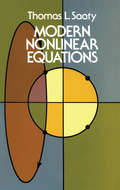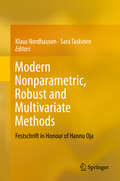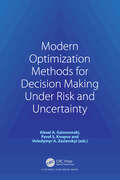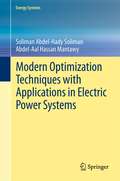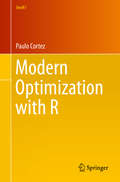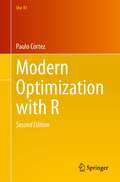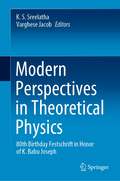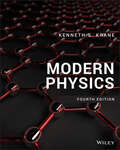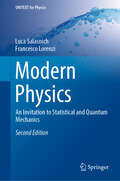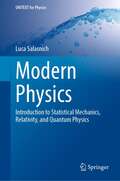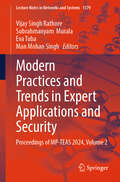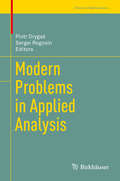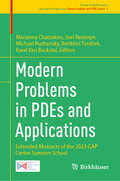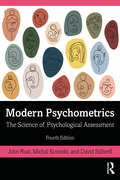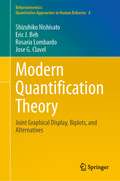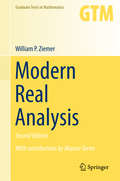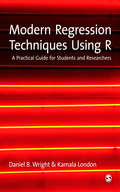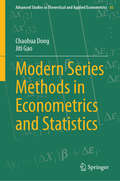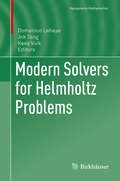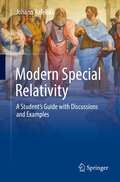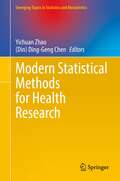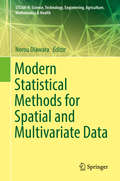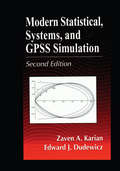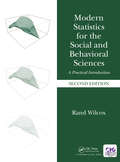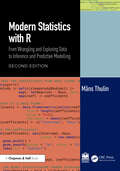- Table View
- List View
Modern Nonlinear Equations
by Thomas L. SaatyThis volume covers many major types of classical equations, including operator equations, functional equations, difference equations, delay-differential equations, integral equations, integro-differential equations, and stochastical differential equations. Its clear organization and copious references make it suitable for graduate students as well as scientists, technologists, and mathematicians. "A welcome contribution." -- Math Reviews. 1964 edition.
Modern Nonparametric, Robust and Multivariate Methods
by Klaus Nordhausen Sara TaskinenWritten by leading experts in the field, this edited volume brings together the latest findings in the area of nonparametric, robust and multivariate statistical methods. The individual contributions cover a wide variety of topics ranging from univariate nonparametric methods to robust methods for complex data structures. Some examples from statistical signal processing are also given. The volume is dedicated to Hannu Oja on the occasion of his 65th birthday and is intended for researchers as well as PhD students with a good knowledge of statistics.
Modern Optimization Methods for Decision Making Under Risk and Uncertainty
by Pavel S. Knopov Alexei A. Gaivoronski Volodymyr A. ZaslavskyiThe book comprises original articles on topical issues of risk theory, rational decision making, statistical decisions, and control of stochastic systems. The articles are the outcome of a series international projects involving the leading scholars in the field of modern stochastic optimization and decision making. The structure of stochastic optimization solvers is described. The solvers in general implement stochastic quasi-gradient methods for optimization and identification of complex nonlinear models. These models constitute an important methodology for finding optimal decisions under risk and uncertainty. While a large part of current approaches towards optimization under uncertainty stems from linear programming (LP) and often results in large LPs of special structure, stochastic quasi-gradient methods confront nonlinearities directly without need of linearization. This makes them an appropriate tool for solving complex nonlinear problems, concurrent optimization and simulation models, and equilibrium situations of different types, for instance, Nash or Stackelberg equilibrium situations. The solver finds the equilibrium solution when the optimization model describes the system with several actors. The solver is parallelizable, performing several simulation threads in parallel. It is capable of solving stochastic optimization problems, finding stochastic Nash equilibria, and of composite stochastic bilevel problems where each level may require the solution of stochastic optimization problem or finding Nash equilibrium. Several complex examples with applications to water resources management, energy markets, pricing of services on social networks are provided. In the case of power system, regulator makes decision on the final expansion plan, considering the strategic behavior of regulated companies and coordinating the interests of different economic entities. Such a plan can be an equilibrium − a planned decision where a company cannot increase its expected gain unilaterally.
Modern Optimization Techniques with Applications in Electric Power Systems
by Abdel-Aal Hassan Mantawy Soliman Abdel-Hady SolimanThis book presents the application of some AI related optimization techniques in the operation and control of electric power systems. With practical applications and examples the use of functional analysis, simulated annealing, Tabu-search, Genetic algorithms and fuzzy systems for the optimization of power systems is discussed in detail. Preliminary mathematical concepts are presented before moving to more advanced material. Researchers and graduate students will benefit from this book. Engineers working in utility companies, operations and control, and resource management will also find this book useful.
Modern Optimization with R
by Paulo CortezThe goal of this book is to gather in a single document the most relevant concepts related to modern optimization methods, showing how such concepts and methods can be addressed using the open source, multi-platform R tool. Modern optimization methods, also known as metaheuristics, are particularly useful for solving complex problems for which no specialized optimization algorithm has been developed. These methods often yield high quality solutions with a more reasonable use of computational resources (e. g. memory and processing effort). Examples of popular modern methods discussed in this book are: simulated annealing; tabu search; genetic algorithms; differential evolution; and particle swarm optimization. This book is suitable for undergraduate and graduate students in Computer Science, Information Technology, and related areas, as well as data analysts interested in exploring modern optimization methods using R.
Modern Optimization with R (Use R!)
by Paulo CortezThe goal of this book is to gather in a single work the most relevant concepts related in optimization methods, showing how such theories and methods can be addressed using the open source, multi-platform R tool. Modern optimization methods, also known as metaheuristics, are particularly useful for solving complex problems for which no specialized optimization algorithm has been developed. These methods often yield high quality solutions with a more reasonable use of computational resources (e.g. memory and processing effort). Examples of popular modern methods discussed in this book are: simulated annealing; tabu search; genetic algorithms; differential evolution; and particle swarm optimization. This book is suitable for undergraduate and graduate students in computer science, information technology, and related areas, as well as data analysts interested in exploring modern optimization methods using R.This new edition integrates the latest R packages through text and code examples. It also discusses new topics, such as: the impact of artificial intelligence and business analytics in modern optimization tasks; the creation of interactive Web applications; usage of parallel computing; and more modern optimization algorithms (e.g., iterated racing, ant colony optimization, grammatical evolution).
Modern Perspectives in Theoretical Physics: 80th Birthday Festschrift in Honor of K. Babu Joseph
by K. S. Sreelatha Varghese JacobThis book highlights the review of articles in theoretical physics by the students of Professor K. Babu Joseph, as a Festschrift for his 80th Birthday. This book is divided into four sections based on the contributions of Babu Joseph and his students. The four sections are Cosmology, High Energy Physics, Mathematical Physics and Non-linear Dynamics and its applications.
Modern Physics
by Kenneth S. KraneOne of the field’s most respected introductory texts, Modern Physics provides a deep exploration of fundamental theory and experimentation. Appropriate for second-year undergraduate science and engineering students, this esteemed text presents a comprehensive introduction to the concepts and methods that form the basis of modern physics, including examinations of relativity, quantum physics, statistical physics, nuclear physics, high energy physics, astrophysics, and cosmology. A balanced pedagogical approach examines major concepts first from a historical perspective, then through a modern lens using relevant experimental evidence and discussion of recent developments in the field. The emphasis on the interrelationship of principles and methods provides continuity, creating an accessible “storyline” for students to follow.
Modern Physics: An Invitation to Statistical and Quantum Mechanics (UNITEXT for Physics)
by Luca Salasnich Francesco LorenziThis textbook offers an introduction to statistical mechanics, special relativity, and quantum physics, developed from lecture notes for the "Quantum Physics" course at the University of Padua. Beginning with a brief review of classical statistical mechanics in the first chapter, the book explores special and general relativity in the second chapter. The third chapter delves into the historical analysis of light quantization, while the fourth chapter discusses Niels Bohr's quantization of energy levels and electromagnetic transitions. The Schrödinger equation is investigated in the fifth chapter. Chapter Six covers applications of quantum mechanics, including the quantum particle in a box, quantum particle in harmonic potential, quantum tunneling, stationary perturbation theory, and time-dependent perturbation theory. Chapter Seven outlines the basic axioms of quantum mechanics. Chapter Eight focuses on quantum atomic physics, emphasizing electron spin and utilizing the Dirac equation for theoretical justification. The ninth chapter explains quantum mechanics principles for identical particles at zero temperature, while Chapter Ten extends the discussion to quantum particles at finite temperature. Chapter Eleven provides insights into quantum information and entanglement, and the twelfth chapter explains the path integral approach to quantum mechanics.
Modern Physics: Introduction to Statistical Mechanics, Relativity, and Quantum Physics (UNITEXT for Physics)
by Luca SalasnichThis book offers an introduction to statistical mechanics, special relativity, and quantum physics. It is based on the lecture notes prepared for the one-semester course of "Quantum Physics" belonging to the Bachelor of Science in Material Sciences at the University of Padova.The first chapter briefly reviews the ideas of classical statistical mechanics introduced by James Clerk Maxwell, Ludwig Boltzmann, Willard Gibbs, and others. The second chapter is devoted to the special relativity of Albert Einstein. In the third chapter, it is historically analyzed the quantization of light due to Max Planck and Albert Einstein, while the fourth chapter discusses the Niels Bohr quantization of the energy levels and the electromagnetic transitions. The fifth chapter investigates the Schrodinger equation, which was obtained by Erwin Schrodinger from the idea of Louis De Broglie to associate to each particle a quantum wavelength. Chapter Six describes the basic axioms of quantum mechanics, which were formulated in the seminal books of Paul Dirac and John von Neumann. In chapter seven, there are several important application of quantum mechanics: the quantum particle in a box, the quantum particle in the harmonic potential, the quantum tunneling, the stationary perturbation theory, and the time-dependent perturbation theory. Chapter Eight is devoted to the study of quantum atomic physics with special emphasis on the spin of the electron, which needs the Dirac equation for a rigorous theoretical justification. In the ninth chapter, it is explained the quantum mechanics of many identical particles at zero temperature, while in Chapter Ten the discussion is extended to many quantum particles at finite temperature by introducing and using the quantum statistical mechanics. The four appendices on Dirac delta function, complex numbers, Fourier transform, and differential equations are a useful mathematical aid for the reader.
Modern Practices and Trends in Expert Applications and Security: Proceedings of MP-TEAS 2024, Volume 2 (Lecture Notes in Networks and Systems #1379)
by Vijay Singh Rathore Subrahmanyam Murala Eva Tuba Man Mohan SinghThis book is a collection of best -selected research papers presented at the International Conference on Modern Practices and Trends in Expert Applications and Security (MP-TEAS 2024). This book contains articles on current trends of machine learning, internet of things, and smart cities applications emphasizing on multi-disciplinary research in the areas of artificial intelligence and cyber- physical systems. The book is a great resource for scientists, research scholars and PG students to formulate their research ideas and find future directions in these areas.
Modern Problems in Applied Analysis (Trends in Mathematics)
by Piotr Drygaś Sergei RogosinThis book features a collection of recent findings in Applied Real and Complex Analysis that were presented at the 3rd International Conference “Boundary Value Problems, Functional Equations and Applications” (BAF-3), held in Rzeszow, Poland on 20-23 April 2016. The contributions presented here develop a technique related to the scope of the workshop and touching on the fields of differential and functional equations, complex and real analysis, with a special emphasis on topics related to boundary value problems. Further, the papers discuss various applications of the technique, mainly in solid mechanics (crack propagation, conductivity of composite materials), biomechanics (viscoelastic behavior of the periodontal ligament, modeling of swarms) and fluid dynamics (Stokes and Brinkman type flows, Hele-Shaw type flows). The book is addressed to all readers who are interested in the development and application of innovative research results that can help solve theoretical and real-world problems.
Modern Problems in PDEs and Applications: Extended Abstracts of the 2023 GAP Center Summer School (Trends in Mathematics #4)
by Michael Ruzhansky Joel Restrepo Karel Van Bockstal Berikbol Torebek Marianna ChatzakouThe principal aim of the volume is gathering all the contributions given by the speakers (mini courses) and some of the participants (short talks) of the summer school "Modern Problems in PDEs and Applications" held at the Ghent Analysis and PDE Center from 23 August to 2 September 2023. The school was devoted to the study of new techniques and approaches for solving partial differential equations, which can either be considered or arise from the physical point of view or the mathematical perspective. Both sides are extremely important since theories and methods can be developed independently, aiming to gather each other in a common objective. The aim of the summer school was to progress and advance in the problems considered. Note that real-world problems and their applications are classical study trends in physical or mathematical modelling. The summer school was organised in a friendly atmosphere and synergy, and it was an excellent opportunity to promote and encourage the development of the subject in the community.
Modern Psychometrics: The Science of Psychological Assessment (International Library Of Psychology Ser.)
by John Rust Michal Kosinski David StillwellThis popular text introduces the reader to all aspects of psychometric assessment, including its history, the construction and administration of traditional tests, and the latest techniques for psychometric assessment online. Rust, Kosinski, and Stillwell begin with a comprehensive introduction to the increased sophistication in psychometric methods and regulation that took place during the 20th century, including the many benefits to governments, businesses, and customers. In this new edition, the authors explore the increasing influence of the internet, wherein everything we do on the internet is available for psychometric analysis, often by AI systems operating at scale and in real time. The intended and unintended consequences of this paradigm shift are examined in detail, and key controversies, such as privacy and the psychographic microtargeting of online messages, are addressed. Furthermore, this new edition includes brand-new chapters on item response theory, computer adaptive testing, and the psychometric analysis of the digital traces we all leave online. Modern Psychometrics combines an up-to-date scientific approach with full consideration of the political and ethical issues involved in the implementation of psychometric testing in today’s society. It will be invaluable to both undergraduate and postgraduate students, as well as practitioners who are seeking an introduction to modern psychometric methods.
Modern Quantification Theory: Joint Graphical Display, Biplots, and Alternatives (Behaviormetrics: Quantitative Approaches to Human Behavior #8)
by Eric J. Beh Rosaria Lombardo Shizuhiko Nishisato Jose G. ClavelThis book offers a new look at well-established quantification theory for categorical data, referred to by such names as correspondence analysis, dual scaling, optimal scaling, and homogeneity analysis. These multiple identities are a consequence of its large number of properties that allow one to analyze and visualize the strength of variable association in an optimal solution. The book contains modern quantification theory for analyzing the association between two and more categorical variables in a variety of applicative frameworks. Visualization has attracted much attention over the past decades and given rise to controversial opinions. One may consider variations of plotting systems used in the construction of the classic correspondence plot, the biplot, the Carroll-Green-Schaffer scaling, or a new approach in doubled multidimensional space as presented in the book. There are even arguments for no visualization at all. The purpose of this book therefore is to shed new light on time-honored graphical procedures with critical reviews, new ideas, and future directions as alternatives. This stimulating volume is written with fresh new ideas from the traditional framework and the contemporary points of view. It thus offers readers a deep understanding of the ever-evolving nature of quantification theory and its practice. Part I starts with illustrating contingency table analysis with traditional joint graphical displays (symmetric, non-symmetric) and the CGS scaling and then explores logically correct graphs in doubled Euclidean space for both row and column variables. Part II covers a variety of mathematical approaches to the biplot strategy in graphing a data structure, providing a useful source for this modern approach to graphical display. Part II is also concerned with a number of alternative approaches to the joint graphical display such as bimodal cluster analysis and other statistical problems relevant to quantification theory.
Modern Real Analysis
by William P. ZiemerThis first year graduate text is a comprehensive resource in real analysis based on a modern treatment of measure and integration. Presented in a definitive and self-contained manner, it features a natural progression of concepts from simple to difficult. Several innovative topics are featured, including differentiation of measures, elements of Functional Analysis, the Riesz Representation Theorem, Schwartz distributions, the area formula, Sobolev functions and applications to harmonic functions. Together, the selection of topics forms a sound foundation in real analysis that is particularly suited to students going on to further study in partial differential equations. This second edition of Modern Real Analysis contains many substantial improvements, including the addition of problems for practicing techniques, and an entirely new section devoted to the relationship between Lebesgue and improper integrals. Aimed at graduate students with an understanding of advanced calculus, the text will also appeal to more experienced mathematicians as a useful reference.
Modern Regression Techniques Using R: A Practical Guide
by Daniel B. Wright Kamala LondonStatistics is the language of modern empirical social and behavioural science and the varieties of regression form the basis of this language. Statistical and computing advances have led to new and exciting regressions that have become the necessary tools for any researcher in these fields. In a way that is refreshingly engaging and readable, Wright and London describe the most useful of these techniques and provide step-by-step instructions, using the freeware R, to analyze datasets that can be located on the books' webpage: www.sagepub.co.uk/wrightandlondon. Techniques covered in this book include multilevel modeling, ANOVA and ANCOVA, path analysis, mediation and moderation, logistic regression (generalized linear models), generalized additive models, and robust methods. These are all tested out using a range of real research examples conducted by the authors in every chapter. Given the wide coverage of techniques, this book will be essential reading for any advanced undergraduate and graduate student (particularly in psychology) and for more experienced researchers wanting to learn how to apply some of the more recent statistical techniques to their datasets. The Authors are donating all royalties from the book to the American Partnership for Eosinophilic Disorders.
Modern Series Methods in Econometrics and Statistics (Advanced Studies in Theoretical and Applied Econometrics #45)
by Jiti Gao Chaohua DongThis book introduces modern series methods with a focus on applications in econometrics and statistics. It explores how new orthogonal series techniques can address challenges in model building and estimation, particularly for variables with unbounded support, nonparametric nonstationary data, and high-dimensional models. By extending traditional series methods, which are typically limited to variables with bounded supports, this book provides tools to tackle emerging problems in econometrics and statistics effectively. The book is organized into the following key parts. Part one provides the mathematical foundation for modern series methods, offering the theoretical background needed for their application. Part two introduces fundamental econometric concepts, including conditional expectations and regression models, within the context of modern series techniques. The last part, part four examines advanced topics, such as the connections between series methods and generalized functions, and compares series methods with kernel methods, highlighting their respective strengths and use cases. With a balanced mix of theory and practical insights, this book is ideal for researchers, practitioners, and students looking to deepen their understanding of series methods and their applications in econometrics, statistics, and related fields.
Modern Solvers for Helmholtz Problems
by Domenico Lahaye Jok Tang Kees VuikThis edited volume offers a state of the art overview of fast and robust solvers for the Helmholtz equation. The book consists of three parts: new developments and analysis in Helmholtz solvers, practical methods and implementations of Helmholtz solvers, and industrial applications. The Helmholtz equation appears in a wide range of science and engineering disciplines in which wave propagation is modeled. Examples are: seismic inversion, ultrasone medical imaging, sonar detection of submarines, waves in harbours and many more. The partial differential equation looks simple but is hard to solve. In order to approximate the solution of the problem numerical methods are needed. First a discretization is done. Various methods can be used: (high order) Finite Difference Method, Finite Element Method, Discontinuous Galerkin Method and Boundary Element Method. The resulting linear system is large, where the size of the problem increases with increasing frequency. Due to higher frequencies the seismic images need to be more detailed and, therefore, lead to numerical problems of a larger scale. To solve these three dimensional problems fast and robust, iterative solvers are required. However for standard iterative methods the number of iterations to solve the system becomes too large. For these reason a number of new methods are developed to overcome this hurdle. The book is meant for researchers both from academia and industry and graduate students. A prerequisite is knowledge on partial differential equations and numerical linear algebra.
Modern Special Relativity: A Student's Guide with Discussions and Examples
by Johann RafelskiThis book presents Special Relativity in a language accessible to students while avoiding the burdens of geometry, tensor calculus, space-time symmetries, and the introduction of four vectors. The search for clarity in the fundamental questions about Relativity, the discussion of historical developments before and after 1905, the strong connection to current research topics, many solved examples and problems, and illustrations of the material in colloquial discussions are the most significant and original assets of this book. Importantly for first-time students, Special Relativity is presented such that nothing needs to be called paradoxical or apparent; everything is explained. The content of this volume develops and builds on the book Relativity Matters (Springer, 2017). However, this presentation of Special Relativity does not require 4-vector tools. The relevant material has been extended and reformulated, with additional examples and clarifications. This introduction of Special Relativity offers conceptual insights reaching well beyond the usual method of teaching relativity. It considers relevant developments after the discovery of General Relativity (which itself is not presented), and advances the reader into contemporary research fields. This presentation of Special Relativity is connected to present day research topics in particle, nuclear, and high intensity pulsed laser physics and is complemented by the current cosmological perspective. The conceptual reach of Special Relativity today extends significantly further compared even to a few decades ago. As the book progresses, the qualitative and historical introduction turns into a textbook-style presentation with many detailed results derived in an explicit manner. The reader reaching the end of this text needs knowledge of classical mechanics, a good command of elementary algebra, basic knowledge of calculus, and introductory know-how of electromagnetism.
Modern Statistical Methods for Health Research (Emerging Topics in Statistics and Biostatistics)
by Yichuan Zhao Din Ding-Geng ChenThis book brings together the voices of leading experts in the frontiers of biostatistics, biomedicine, and the health sciences to discuss the statistical procedures, useful methods, and novel applications in biostatistics research. It also includes discussions of potential future directions of biomedicine and new statistical developments for health research, with the intent of stimulating research and fostering the interactions of scholars across health research related disciplines. Topics covered include: Health data analysis and applications to EHR data Clinical trials, FDR, and applications in health science Big network analytics and its applications in GWAS Survival analysis and functional data analysis Graphical modelling in genomic studies The book will be valuable to data scientists and statisticians who are working in biomedicine and health, other practitioners in the health sciences, and graduate students and researchers in biostatistics and health.
Modern Statistical Methods for Spatial and Multivariate Data (STEAM-H: Science, Technology, Engineering, Agriculture, Mathematics & Health)
by Norou DiawaraThis contributed volume features invited papers on current models and statistical methods for spatial and multivariate data. With a focus on recent advances in statistics, topics include spatio-temporal aspects, classification techniques, the multivariate outcomes with zero and doubly-inflated data, discrete choice modelling, copula distributions, and feasible algorithmic solutions. Special emphasis is placed on applications such as the use of spatial and spatio-temporal models for rainfall in South Carolina and the multivariate sparse areal mixed model for the Census dataset for the state of Iowa. Articles use simulated and aggregated data examples to show the flexibility and wide applications of proposed techniques.Carefully peer-reviewed and pedagogically presented for a broad readership, this volume is suitable for graduate and postdoctoral students interested in interdisciplinary research. Researchers in applied statistics and sciences will find this book an important resource on the latest developments in the field. In keeping with the STEAM-H series, the editors hope to inspire interdisciplinary understanding and collaboration.
Modern Statistical, Systems, and GPSS Simulation, Second Edition
by Zaven A. Karian Edward J. DudewiczModern Statistical, Systems, and GPSS Simulation, Second Edition introduces the theory and implementation of discrete-event simulation. This text:establishes a theoretical basis for simulation methodologyprovides details of an important simulation language (GPSS - General Purpose Simulation System)integrates these two elements in a systems simulation case studyValuable additions to the second edition include coverage of random number generators with astronomic period, new entropy-based tests of uniformity, gamma variate generation, results on the GLD, and variance reduction techniques.GPSS/PC is an interactive implementation of GPSS for the IBM-PC compatible family of microcomputers. The disk accompanying Modern Statistical, Systems, and GPSS Simulation contains the limited educational version of GPSS/PC with many illustrative examples discussed in the text.
Modern Statistics for the Social and Behavioral Sciences: A Practical Introduction (Second Edition)
by Rand Wilcox<p>Requiring no prior training, Modern Statistics for the Social and Behavioral Sciences provides a two-semester, graduate-level introduction to basic statistical techniques that takes into account recent advances and insights that are typically ignored in an introductory course. <p>Hundreds of journal articles make it clear that basic techniques, routinely taught and used, can perform poorly when dealing with skewed distributions, outliers, heteroscedasticity (unequal variances) and curvature. Methods for dealing with these concerns have been derived and can provide a deeper, more accurate and more nuanced understanding of data. A conceptual basis is provided for understanding when and why standard methods can have poor power and yield misleading measures of effect size. Modern techniques for dealing with known concerns are described and illustrated. <p>Features: <p> <li>Presents an in-depth description of both classic and modern methods <li>Explains and illustrates why recent advances can provide more power and a deeper understanding of data <li>Provides numerous illustrations using the software R <li>Includes an R package with over 1300 functions <li>Includes a solution manual giving detailed answers to all of the exercises</li> <p> <p>This second edition describes many recent advances relevant to basic techniques. For example, a vast array of new and improved methods is now available for dealing with regression, including substantially improved ANCOVA techniques. The coverage of multiple comparison procedures has been expanded and new ANOVA techniques are described.</p>
Modern Statistics with R: From Wrangling and Exploring Data to Inference and Predictive Modelling
by Måns ThulinThe past decades have transformed the world of statistical data analysis, with new methods, new types of data, and new computational tools. Modern Statistics with R introduces you to key parts of this modern statistical toolkit. It teaches you: Data wrangling – importing, formatting, reshaping, merging, and filtering data in R. Exploratory data analysis – using visualisations and multivariate techniques to explore datasets. Statistical inference – modern methods for testing hypotheses and computing confidence intervals. Predictive modelling – regression models and machine learning methods for prediction, classification, and forecasting. Simulation – using simulation techniques for sample size computations and evaluations of statistical methods. Ethics in statistics – ethical issues and good statistical practice. R programming – writing code that is fast, readable, and (hopefully!) free from bugs. No prior programming experience is necessary. Clear explanations and examples are provided to accommodate readers at all levels of familiarity with statistical principles and coding practices. A basic understanding of probability theory can enhance comprehension of certain concepts discussed within this book.In addition to plenty of examples, the book includes more than 200 exercises, with fully worked solutions available at: www.modernstatisticswithr.com.
